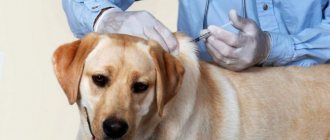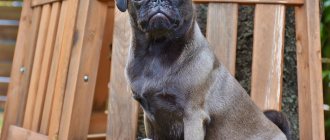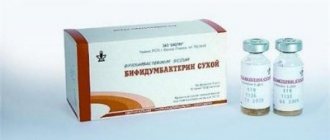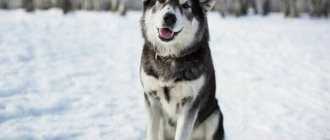- Pug
8965
When you decide to have a pet, you should know how to choose a pug puppy and how to properly care for it. The dog must be independent, not dependent on its mother, and be accustomed to walks.
- Choosing a puppy
- Types of classes
- Appearance of the puppy
- Main characteristics of pugs
- Communication with the breeder Share link:
Breed information
Pugs are originally from China . They are very smart, calm, friendly and affectionate. Sometimes they are lazy, so it is necessary to train them from childhood, and also walk them twice a day.
You need to start training pugs from early childhood.
To more successfully carry out commands, try to have frequent contact with the puppy so that he remembers you faster.
There is no need to overload your pet with frequent execution of the same command. New teams need to be added gradually.
Puppies are very cheerful, love to play and have fun. They are quite unpretentious, but at the same time they are very attached to their owners, reliable, and, despite their small stature, they are always ready to defend the family.
Young animals need to be fed more often than adults, since during the growth period pugs spend a lot of energy and need vitamins.
The following scheme applies for puppies: 1 - 2 months - 6 feedings per day, 2 - 4 months - 5 feedings, 4 - 6 months - 4 feedings, 6 - 12 months - 3 feedings.
Choosing the gender of the puppy
The age-old question when choosing a pet: boy or girl? If there are established preferences for one gender or another, then the choice is obvious. If the future owner is indifferent to the gender of the pet, some nuances will help determine the choice.
Pug boy
Good-natured, playful, inquisitive and loyal friend. Gets along well with other pets, even if they are males. But, despite the role of a good-natured person, he is a fierce guard, fearlessly rushing to protect his owners and home, not paying attention to the size of the stranger. Jealously guards its territory, marking it in many places in a well-known way.
The same applies to the territory outside the home - during a walk, every more or less elevated landscape will be marked, and also actively reacts to the smell of a bitch in heat. You may have to stock up on patience and detergents to clean the apartment, but the joy that this merry fellow will bring to your home will make up for the trouble he has caused a hundredfold.
Pug girl
A generous, kind, self-possessed lady. Unlike the male pug, she is calm and patient, she doesn’t fuss during walks, but calmly allows herself to be admired. Lovers of cleanliness in the house will have to stock up on special devices, since by the dictates of nature, pug bitches go into heat twice a year.
It lasts on average 23 days, of which only in the first and last week the discharge is bloody. Any pet pants will solve this problem. During walks, you should watch her more closely and keep away male dogs of other breeds.
Return to content
Communication with the breeder
Having chosen the puppy you like, you should consult with the owner of the kennel. Boys and girls need different care. We must not forget about vaccinations and deworming of puppies.
Also, you need to find out if he is a reseller, otherwise there is a possibility that he is saving on keeping the puppies, which means the dogs are in poor conditions.
Pug boys are well suited for a show career; they do not have to bear and care for the puppies that are born. They are always in shape, well-groomed and cheerful.
Girls can also participate in exhibitions, but sometimes, as a result of the birth of puppies, the dog may miss the competition or be pregnant at that time. Girls are more suitable for breeding. Pets make loving mothers.
Where is the best place to buy
You can buy a pug cheaply at the poultry market. But you will not receive any guarantees that the dog is healthy, was born and raised in good conditions. Unscrupulous sellers pass off purebred dogs as pugs, and when your pet grows up, you may be in for an unpleasant surprise.
The second option is the Internet. The sites offer many advertisements. Kutyats are often sold by people who already have pugs at home, and regularly bring puppies. The dogs are in good conditions, but often they do not have a pedigree or vaccinations.
The most reliable place is a specialized nursery with a good reputation. Advantages of purchasing:
- the puppy is taken care of from the moment of its life in the womb, mothers provide optimal conditions and diet for bearing the fetus;
- specialists provide lifelong consultations;
- there is an opportunity to look at the dog’s parents;
- the seller provides a full package of documents.
Please note that when purchasing, in all three cases, you can meet a good or bad seller, receive real or fake documents. You should not overly trust reviews on the Internet; it is better to buy a pug through someone you know. If this is not possible, carefully study all the documents and have a detailed conversation with the seller.
Popular sections:
Aquariums Sale of kittens and puppies Terrariums Products for cats Products for dogs
How long does a dog bear puppies?
Pregnancy in pugs lasts about two months. At the very beginning, there are practically no changes in the appearance of the animal. But gradually the dog’s body begins to rebuild. After all, already from the second week, active growth of embryos begins in her stomach.
By the middle of pregnancy, the animal's behavior changes somewhat: the dog becomes less active, sleeps more, gains weight (which increases the need for food), its abdomen and mammary glands enlarge, and urination occurs less frequently.
For a more accurate result, you need to visit a veterinary hospital.
It is recommended to feed a pregnant dog three times a day.
Skin diseases
The most common skin disease of pugs is juvenile demodicosis.
However, allergic reactions accompanied by itching are no less common.
Because of this, the dog scratches the problem area, sometimes to the point of meat. In order not to mistake allergy symptoms for bites of fleas or other parasites, it is necessary to examine the genitals and abdomen of the pet.
If there are no characteristic red pimples with a red dot in the center, it is an allergy. Atopic dermatitis, which appears as itchy, inflamed areas on the face, armpits, between the toes and around the anus, is caused by food allergens, pollen, house dust and others. The disease is treated by subcutaneous injection of the allergen in gradually increasing concentrations.
All procedures must be carried out only in a veterinary clinic!
Just a few "or's"
If you are ready to give part of your time to your future pet, to care for it, feed it, walk it, treat it, then you only have to clarify a few possible options for choosing a dog:
- male or female;
- the puppy is small or older;
- color - black, beige or apricot;
- price - expensive or cheap pug.
But in any case, pug puppies presented for selection must be healthy, well-fed and active.
What to feed a puppy up to one month?
Let's summarize: How much to feed a puppy from one month to three months.
- th recipe for feeding puppies: semolina porridge with goat's milk, which is subsequently replaced with meat porridge with rice or buckwheat with the addition of carrots and olive oil. ...
- th recipe for feeding puppies: cottage cheese product - cottage cheese with kefir, with the addition of raw eggs and honey.
Interesting materials:
Where and with whom does Kazakhstan border? Where is the comedy club? Where does fat breakdown take place? Where to look for figures in GTA 5? Where to look for volushka mushrooms? Where to look for Internet Explorer in 10? Where can I find the copied link on my computer? Where to look for the second fugitive in GTA 5? Where to look for a hare in autumn? Where was sacred music performed?
To what age do they grow?
Pug puppies grow quite quickly, with the most changes occurring in the first two months.
With proper nutrition, pugs gain their maximum normal weight by the age of one year (from 9 to 12 months).
However, some dogs can continue to grow for up to 18 months. A healthy adult weighs from 6 to 8 kg and reaches a height of 28 to 32 cm. These dogs live 13 - 15 years.
Stages of growing up
Newly born puppies can sleep up to 22 hours; by two months the sleep period reaches 18 hours a day. During this period of time, puppies very quickly double their weight, and the foundations of the individual’s health are also laid. From the third week of life, puppies need to be weighed weekly.
Puppies that are well fed breast milk are likely to develop faster and be larger and healthier than their counterparts.
At about two months of age, the puppy is ready to go to a new home. During this period, weight development slows down sharply, but with proper feeding, weight will gradually increase.
From three to four months, baby teeth are gradually replaced by molars (this stage will last several months).
From four to six, puberty begins and females experience their first estrus.
In fact, pregnancy can already occur at this age, but it is recommended to start breeding pugs no earlier than one year.
After nine months, the animal’s growth slows down, and by one year the individual will reach its adult weight.
A one-year-old pug is considered fully grown, but may still exhibit his puppy habits. From one year to one and a half years, dogs reach their maximum weight and height, and their muscles fully develop.
First vaccinations
When the dog is 2 months old, you can give it its first vaccinations. 10 days before vaccination (sometimes 2 weeks, which is agreed with the doctor), the puppy is given anthelmintic drugs.
Important! On the day the vaccination is scheduled, the animal should feel good, healthy and vigorous. You cannot vaccinate a sick dog!
After vaccination, the dog is not washed for a week or 10 days. After 2-3 weeks, the 2nd vaccination is given - the puppy should be healthy and feel good. 2 weeks after this is the incubation period, when the pug still goes to the litter tray; washing the pet is also not recommended.
The next vaccination occurs at the age of 11 months (closer to 1 year), and then the pug is vaccinated annually. It is important not to forget to get vaccinated on time!
Pugs can be distinguished as one of the easiest dogs to care for and have a pleasant character. But remember: babies are very curious and will run after you everywhere. Therefore, it is important to constantly clean the house, remove hair (pugs shed a lot), and not leave small objects on the floor that the pet could swallow. Select a quiet place for the puppy, where there is no draft or heat, then the baby will be comfortable in his new home.
Always remains a pug
In the article about colors, we said that pug puppies change colors with age. Therefore, when looking at babies, you can only imagine their future coat color approximately. It is possible that the beige color recorded in the pedigree will eventually turn into apricot. But such a metamorphosis is unlikely to spoil your relationship with your pet. You will always see a black puppy right away, as well as a dark “mask” on the face of a light one.
Keep in mind that coat color does not in any way affect the dog’s mental abilities, health, character or temperament. A pug always remains itself and retains its breed characteristics no matter the color.
The parameters you need to look at when choosing pug puppies are presented in the table:
Useful tips
If a person doubts his ability to choose the perfect puppy, he can turn to professionals. Experienced dog handlers will help you choose a puppy for a show career and breeding, and will also select a healthy, attractive pet-class pet.
Professionals will also help you save money, as some unscrupulous sellers try to sell pet-class animals as show dogs. This fraud can be nipped in the bud if you immediately seek help from dog handlers and breed specialists.
Choosing a puppy is a responsible undertaking. Before getting a pug, you need to soberly assess your capabilities, and also enlist the support of everyone at home. It will be a big blow for a little pug that someone did not accept him in his new home. Take care of your puppy's comfort in advance.
Similar articles
Changing teeth
Replacing baby teeth with molars is the main indicator of growth and development of puppies.
| 1 month | There are canines, incisors, first and second false teeth. |
| 2 months | All baby teeth grow in. |
| 3 months | Changing the central incisors. |
| From 3 to 5 months | The middle incisors change. |
| 4 to 6 months | The edges (outer incisors) change. |
| From 4 to 5 months of age | Changing fangs. |
| 5 - 6 months | Replacement of false-rooted teeth. |
| 7 months | Molars grow (42 permanent teeth). |
Slower growth of teeth, their weakness and fragility indicate improper development of the animal, the reason being the lack of vitamins A and D and mineral salts in food.
Caring for a puppy: what is important for the owner to know
If your pug is expecting a litter, monitor the pregnancy with your doctor. There are situations when a pug giving birth requires the help of a doctor - in this case, arrange with the veterinarian to call him. In the first weeks after birth, try not to leave the puppies and mother unattended for more than 1.5-2 hours. In ideal cases, the dog takes care of the puppies itself, but you need to constantly monitor whether they are licked, whether everyone has had enough milk, you need to listen to their breathing, and, if necessary, wipe the mucus from the eyes and nose.
From the age of 1 month, puppies are given complementary foods - porridge cooked in milk and ground minced meat (beef) steamed.
Add 1-2 drops of vegetable oil to the porridge.
Upon reaching 2 months, puppies can be weaned from their mother, switching them to natural food or giving them wet food.
Important! Puppies' nails begin to be trimmed at the age of several weeks to prevent them from scratching their mother. Then this procedure is carried out once every 3 weeks. If you have adopted a dog, but don’t know how to trim its nails, then buy a nail clipper of the right size (according to the dog’s size) and go to the veterinarian, who will teach you this simple manipulation. Pugs are usually relaxed about trimming their nails.
The first shedding in babies begins after 1.5 months, so you need to start brushing them 2-3 times a week with a soft brush (with natural bristles).
Also required daily procedures include: wiping the folds of the muzzle with a rag moistened with warm water or hydrogen peroxide, checking the ear (there should be no wax or unpleasant odor), and also wiping the dog’s eyes with warm water. Dental care is an important procedure. Buy your dog a special toothpaste and toothbrush and brush your pet’s teeth once a week.
Wash the baby no more than once a month, or if the dog is very dirty.
If the puppy is not vaccinated, then walking on the street is prohibited - show the pug a litter box and teach him to go there. Usually, by the behavior of babies, you can determine that they want to go to the toilet - they squeak, fidget, and try to settle down.
Advice! Place your puppy in the litter box in the morning and after every feeding. Afterwards, praise the baby and give him a treat.
Training can be done if the pug is 3 months old. Teach him the simplest commands: “Come to me!”, “Ugh!”, so that you feel comfortable walking with your dog on the street and he doesn’t pick up everything from the ground. Take walks more often, but not for long, without excessive stress, so that your pet’s breathing does not become difficult.
What else should you pay attention to?
A breeder offering a litter for sale must take the buyer to the place where the female is kept and show the conditions in which the puppies are kept. It should be a well-ventilated, warm, clean and dry place where mother and puppies are kept perfectly clean. The litter and box must be washed clean and lined with clean diapers or other material.
There should be no unpleasant odor in the room, and the puppies should be well-fed and playful. It is worth paying attention to the father and mother of the puppies. It is also recommended to study their pedigrees to ensure that the animals do not have hereditary diseases.
Many. It is very important that a spiritual connection be established between the pet and its owner. This is the only way to establish wonderful relationships and become true companions.
What to ask the breeder
When planning to meet with a breeder, remember useful questions that will help you not get confused when purchasing and find a healthy puppy.
| Question | Expected response |
| Does the seller breed the puppies himself or does he repurchase them? | Only the breeder can guarantee that the dog is healthy and meets breed standards. |
| What date was the puppy born? | It is believed that the first puppy, especially if it is a male, is the strongest and strongest. |
| Are there any vaccinations? | The dog must be vaccinated according to age |
| What are the conditions of detention? | The breeder must tell, or better yet show, the conditions in which the puppies live, what and how often they eat |
| Can I look at my parents? | Puppies receive 60 - 80% of their qualities from their mother. The seller should demonstrate or tell about the kitten’s mother; it would be useful to obtain information about the father. |
| Has the litter been dewormed? | The procedure must be carried out 10 days before the 1st vaccination in the puppy’s life. |
How to choose the right one when purchasing?
| Puppy classes (there are puppies of different classes in one litter) | |
| The show is great | Highest price. Designed for exhibitions. |
| Brid is class | Suitable for breeding high-quality, healthy offspring. They may also have show class puppies. |
| Pet - class | They do not meet all breed standards, but can make great friends. |
It is best to get a puppy from experienced breeders who have been dealing with pugs for a long time.
Colors
- Fawn (“fawn” or beige-brown).
- Silver (“moonlight silver fawn”).
- Black.
- Apricot (“apricot” or “sunlight fawn”).
Rich colors are more appreciated.
The presence of white and red hairs is considered a defect (the coat must be uniform).
If the fur is light, then there is always a black mask on the muzzle, and a “belt” (dark stripe) runs from the occipital protuberance to the base of the tail. The rarest color is black, followed by apricot. The classic color is beige.
A puppy's color can change over time, and sometimes a puppy with a prestigious color may even lose its show dog status. To avoid such a problem, before purchasing, you need to ask the breeders to show the parents of the puppies, and also study the pedigree.
| Examination of the puppy | |
| Wool | Shiny, without lice or bald spots. |
| Leather | No defects (redness, blisters, swelling, etc.). |
| Eyes | Clean, no discharge (there may be some slight discharge after sleep). |
| Nose | Cold, it often releases a clear liquid (created by a concentrate). |
| Ears | Clean, not hot, without rashes or redness. |
| Teeth | White, your breath should not smell bad. |
| Stomach | Elastic, protruding, not swollen. |
| Genitals | There is no unpleasant discharge; by the age of 3 months, the boy’s testicles should already descend into the scrotum. |
It is also necessary to find out from the breeder the following details: how the baby was born (the first one is considered the strongest), whether all vaccinations were done, what the puppy was fed and how it was cared for, whether deworming was carried out (deworming).
Pedigree
If you plan to participate in exhibitions for your pet, then he needs a pedigree. The procedure for obtaining a pedigree is determined by the Russian Cynological Federation (RKF). The website of this organization contains all the regulations and documents relating to the breeding of dogs of different breeds.
If you want to start breeding pugs or their participation in various exhibitions, then you need to purchase a purebred puppy.
The first document of the puppy is the metric.
After the puppy has reached six months of age, you can start compiling a pedigree (at this time, data about it has already been received by the RKF).
You need to take a puppy card, come to the Russian Cynological Federation and get a pedigree.
It is not necessary to go to the capital for this; you can join the official dog breeding club in your city (and register a pedigree at your place of residence).
Passport
Another important document for a dog is a veterinary passport.
It has nothing to do with pedigree.
This is an international veterinary document; it contains all the information about the animal , as well as the owner’s data.
Based on the passport, you can obtain certificates for the export of a pug.
Take part in the exhibition, confirm the safety of your dog. The passport records all vaccinations and anti-parasitic treatments.
You can find out everything about obtaining a veterinary passport at the veterinary clinic of your choice.
It is recommended to carry out microchipping - the introduction of a capsule containing a unique fifteen-digit code. This procedure helps solve many problems related to pet identification.
Bases
There is an electronic database of pug pedigrees: https://ingrus.net/pug/
Less hassle with teenagers
At what age to choose a pug also depends on your desire. If you prefer a small puppy, it is better that he is already two months old. Then he will be more independent. By this age, the breeder will have already taught him to eat from a bowl and, perhaps, even go to the toilet in a diaper.
When choosing a puppy, be sure to ask what birth mark it was. Usually the first babies are stronger in terms of health. To avoid problems with nutrition, find out what he was fed and whether he was dewormed.
If you want to take an already grown puppy (3-8 months), then you can get a dog with a full set of vaccinations and already trained to use the toilet outside. But there is also a risk of getting an animal with developed character flaws.
A pug under the age of one year gets used to its new owner quite easily. Usually this period does not take much time. Within a week, the teenager will feel completely free.
By choosing a mature puppy, you will more clearly see the color, condition of the teeth, fur, bones, ear set and tail. When assessing posture, take a special look at the dog when it is standing. It is in the rack that all the advantages of the case are clearly visible. It should be square, that is, the height at the withers should be equal to the length of the body.
Types of classes
Pug puppies are divided into three classes and are purchased depending on the goals and tasks assigned to the dog:
– show pugs (Show class)
These are dogs that meet the breed standard; they are purchased for further exhibitions. Such pets require more time for care and sufficient financial investment from the owner.
To provide a dog with a good exhibition career, it will take a lot of effort and patience. The dog can be black or beige in color.
– pets for breeding (Breed class)
An elite breed, slightly inconsistent with the Shaw class, but as a result of breeding, it produces strong and healthy offspring. Puppies are cheaper than show puppies, but are no less charming and friendly.
– Pet class
Pets have a slight defect: the dog’s ears may not be positioned correctly, the color may not correspond to breed standards (neither beige nor black). Such dogs are cheaper and will become a faithful friend to the owner who does not intend to breed and attend exhibitions.
Valuation in money
Now we just have to find out how much a pug costs. Its cost also depends on what class the dog you choose belongs to. This is the main parameter for assessing a dog in monetary terms. As the analysis showed, the gender or color of the pug does not matter here. The price is set by class. Pet-class puppies are much cheaper than dogs intended for breeding or exhibitions.
Slight downward price fluctuations depend on the geographical location of the breeders. However, often they themselves offer delivery of puppies to the place completely free of charge.
In Moscow and other large cities, prices range from 250 to 750 dollars. Accordingly, the initial amount is the cost of pets that do not participate in breeding or exhibitions. The final one is for future champions.
In central Russia and the south, the cost of pugs for show does not exceed $450, and the countdown starts at $160. This dispersion of numbers is not at all due to the fact that puppies in the provinces are worse. It is simply much more difficult to realize offspring in remote and sparsely populated areas.
At almost half the price of a breeding nursery, you can buy a good puppy from a private owner. Also, the price increases as the puppy grows up, if it has the mark and pedigree of the RKF.
Please like it if you liked this article and don't forget to share it with your friends.
Write a comment on our website, it is very important for us to know your opinion.
Training and education
The stubbornness of pugs does not allow these dogs to carry out the commands that people try to teach them to do. Many owners are faced with the fact that the dog follows a command only if it sees that it will be followed by a treat. Therefore, in order to get the dog to perform the desired action, the owner will have to be very patient. A positive aspect and feature of the breed is that a pug can be easily trained to use a litter tray or diaper, and in rainy weather you won’t have to go outside with the dog.
Pug dog – who is this breed for?
If you are looking for a playful little puppy with a funny face, one of the main advantages of which is a great love, spiced with a little mischief, then the Pug dog will be the ideal pet for you. These dogs get along well in any family, famously adopting the basic character traits of their owners. However, most of all they are most comfortable in a loving group with a large number of children. After a couple of months of keeping a pug, adults begin to notice that the dog begins to behave in the same way as a child.
Among other things, it cannot be said that pugs are dogs devoid of intelligence. Rather, they are unbridled merrymakers who are not aware of their actions. These are peculiar toys that adore the company of their owners and give a smile absolutely free of charge, either through their stupid behavior or gentle licks, which are often compared to kisses. In addition, due to its small size, this breed is ideal for keeping even in a small one-room apartment or house. But it is strictly not recommended to keep a pug outside - its body temperature regulation is poorly developed, so the dog can easily overheat in the heat or freeze in sub-zero temperatures. This is also worth remembering while walking.
Short story
Pugs have ancient origins. Tibet is considered the birthplace of the breed. The ancestors of pugs (Sichuan fu dogs) lived in monasteries. Tibetan monks called them “Buddha's heavenly lions” and believed that these dogs brought happiness, health and longevity.
Over time, pugs began to be introduced into the palaces of Chinese emperors. The breeding of pugs was carried out by a person close to the emperor - Chanqian. Dogs were involved in the entertainment of the imperial family - holidays, travel and hunting. Dogs were given special honors, and sometimes they were assigned servants.
During the period from 207 BC–220 AD. Pugs have spread to almost all Asian countries. From the 10th to the beginning of the 20th century, this breed was called Lao Tse (a symbol of fame and wealth). In some sources - Lo-Tse.
Lao-Tse came to Europe at the end of the 16th century, and there the breed received its final name - pug.
The first pugs were brought to Russia in the 19th century. Their original appearance and affectionate, friendly character gradually earned them universal love all over the world.
NOTE!
In Holland, a dog of this breed is usually called “Chinese Mastiff”, in France – “Carlin”, in England – “Pug”.











